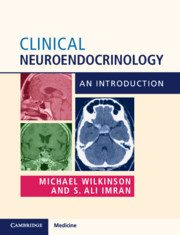Book contents
- Clinical Neuroendocrinology
- Clinical Neuroendocrinology
- Copyright page
- Dedication
- Contents
- Preface
- Acknowledgments
- Chapter 1 Basic Principles in Clinical Neuroendocrinology I: Receptor Mechanisms
- Chapter 2 Basic Principles in Clinical Neuroendocrinology II: Assays, Rhythms and Pulses
- Chapter 3 Neuroendocrinology of Female Reproduction
- Chapter 4 Neuroendocrine Regulation of Appetite and Body Weight
- Chapter 5 Hypothalamic–Pituitary–Adrenal Cortex Axis
- Chapter 6 Hypothalamic Regulation of Thyroid Function
- Chapter 7 Hypothalamic Regulation of Prolactin Secretion
- Chapter 8 Regulation of Growth Hormone Secretion
- Chapter 9 Posterior Pituitary
- Chapter 10 An Introduction to Sellar Masses
- Appendix Answers to Review Questions
- Index
- References
Chapter 9 - Posterior Pituitary
Published online by Cambridge University Press: 24 December 2018
- Clinical Neuroendocrinology
- Clinical Neuroendocrinology
- Copyright page
- Dedication
- Contents
- Preface
- Acknowledgments
- Chapter 1 Basic Principles in Clinical Neuroendocrinology I: Receptor Mechanisms
- Chapter 2 Basic Principles in Clinical Neuroendocrinology II: Assays, Rhythms and Pulses
- Chapter 3 Neuroendocrinology of Female Reproduction
- Chapter 4 Neuroendocrine Regulation of Appetite and Body Weight
- Chapter 5 Hypothalamic–Pituitary–Adrenal Cortex Axis
- Chapter 6 Hypothalamic Regulation of Thyroid Function
- Chapter 7 Hypothalamic Regulation of Prolactin Secretion
- Chapter 8 Regulation of Growth Hormone Secretion
- Chapter 9 Posterior Pituitary
- Chapter 10 An Introduction to Sellar Masses
- Appendix Answers to Review Questions
- Index
- References
- Type
- Chapter
- Information
- Clinical NeuroendocrinologyAn Introduction, pp. 154 - 170Publisher: Cambridge University PressPrint publication year: 2019

